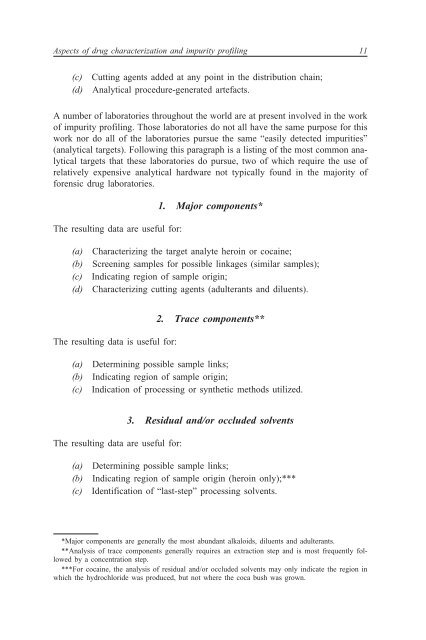methods for impurity profiling of heroin and cocaine - United Nations ...
methods for impurity profiling of heroin and cocaine - United Nations ...
methods for impurity profiling of heroin and cocaine - United Nations ...
Create successful ePaper yourself
Turn your PDF publications into a flip-book with our unique Google optimized e-Paper software.
Aspects <strong>of</strong> drug characterization <strong>and</strong> <strong>impurity</strong> <strong>pr<strong>of</strong>iling</strong> 11<br />
(c) Cutting agents added at any point in the distribution chain;<br />
(d) Analytical procedure-generated artefacts.<br />
A number <strong>of</strong> laboratories throughout the world are at present involved in the work<br />
<strong>of</strong> <strong>impurity</strong> <strong>pr<strong>of</strong>iling</strong>. Those laboratories do not all have the same purpose <strong>for</strong> this<br />
work nor do all <strong>of</strong> the laboratories pursue the same “easily detected impurities”<br />
(analytical targets). Following this paragraph is a listing <strong>of</strong> the most common analytical<br />
targets that these laboratories do pursue, two <strong>of</strong> which require the use <strong>of</strong><br />
relatively expensive analytical hardware not typically found in the majority <strong>of</strong><br />
<strong>for</strong>ensic drug laboratories.<br />
The resulting data are useful <strong>for</strong>:<br />
1. Major components*<br />
(a) Characterizing the target analyte <strong>heroin</strong> or <strong>cocaine</strong>;<br />
(b) Screening samples <strong>for</strong> possible linkages (similar samples);<br />
(c) Indicating region <strong>of</strong> sample origin;<br />
(d) Characterizing cutting agents (adulterants <strong>and</strong> diluents).<br />
The resulting data is useful <strong>for</strong>:<br />
2. Trace components**<br />
(a) Determining possible sample links;<br />
(b) Indicating region <strong>of</strong> sample origin;<br />
(c) Indication <strong>of</strong> processing or synthetic <strong>methods</strong> utilized.<br />
The resulting data are useful <strong>for</strong>:<br />
3. Residual <strong>and</strong>/or occluded solvents<br />
(a) Determining possible sample links;<br />
(b) Indicating region <strong>of</strong> sample origin (<strong>heroin</strong> only);***<br />
(c) Identification <strong>of</strong> “last-step” processing solvents.<br />
*Major components are generally the most abundant alkaloids, diluents <strong>and</strong> adulterants.<br />
**Analysis <strong>of</strong> trace components generally requires an extraction step <strong>and</strong> is most frequently followed<br />
by a concentration step.<br />
***For <strong>cocaine</strong>, the analysis <strong>of</strong> residual <strong>and</strong>/or occluded solvents may only indicate the region in<br />
which the hydrochloride was produced, but not where the coca bush was grown.

















